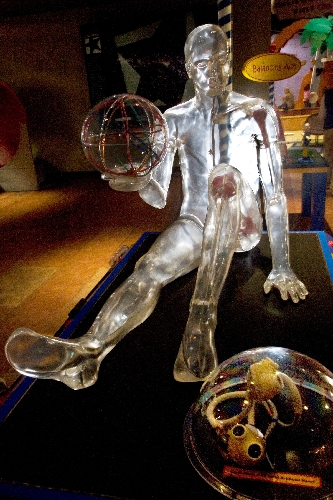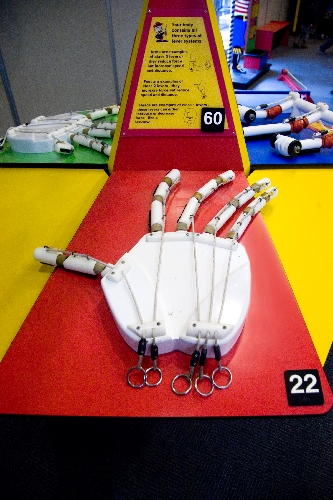Children’s museum focuses on understanding our bodies
They call it "Goofy Goggles."
We call it preparing for college keggers.
Slip on those goggles that severely distort your vision and try walking a marked, crooked path. No alcohol is involved, but the physical sensation is suspiciously familiar.
"It's almost like intoxication," says Tifferney White, deputy director of the Lied Discovery Children's Museum. "Don't try to have five glasses of wine and come back and try this."
Fortunately, that's behavior most of the under-10 crowd hasn't indulged in when they arrive at "Body Carnival: The Science and Fun of Being You," the exhibit that outlines vital functions of the human body for the toddler and kiddie contingents.
"They pick up things playing right here that (adults) might not even know," says California visitor Mark Duldulao, as his two sons, 6-year-old Andre and 4-year-old Marco, bounce around like rubber balls among exhibits labeled "Get a Grip," "Body Challenge," "Walk the Plank" and "Dizzy Tunnel."
What don't you know going in that you might going out? Maybe that simple speech requires the use of at least 100 muscles. Or that in an average lifetime, we produce enough saliva to -- gross alert, here -- fill a medium-size pool (try not to picture it).
Or that you should divide your body weight by 16 to arrive at the number of 8-ounce glasses of water you should drink daily to regulate your blood temperature and maintain organ function. "We did the 'Calculation Station,' and I need to be drinking a lot more water -- a lot more," says Amy Urrea, strolling around the exhibit with one eye on her gallivanting 3-year-old, Gabriel. "I had no idea I needed to drink that much."
Created by the Catawba Science Center in Hickory, N.C., "Body Carnival" (no carnival-esque cotton candy booths, sorry, kids) is the third featured exhibit to visit the museum this year and includes 18 interactive components that explore concepts such as force and pressure, light and sound, and the laws of motion.
"It's going in and playing in the body," White says. "They teach these concepts in the classroom anyway, but this is a way to put it in a hands-on way so the kids can interact with the exhibit."
Yes they can, though the youngsters dash from one to the other, pulling levers and scampering through tunnels and crawl spaces as they would at a McDonald's playroom.
"I don't think he's making a connection yet to the body," Urrea says about little Gabe, though she did try to educate him when it came to the "Tunnel of Blood," a giant crawl-through re-creation of a coronary artery. Panels explain how it provides blood and oxygen to the heart (accompanied by a pumping sound), but the exhibit also shows one branch blocked and details how pieces of plaque can narrow the artery until the flow stops and a heart attack occurs.
"His sister has a heart condition, so that was interesting," Urrea says. "I was trying to explain to him about the arteries and what she has under the arteries."
Elsewhere around the body-palooza, "Get a Grip" features a giant hand with pull levers to test strength, finger motion and the wrist muscles. (When manipulating the hand, try not raising only the middle finger, kids. It's rude.) "Walk the Plank," complete with a pirate image, challenges people to walk on two bars, the second narrower than the first, then steady themselves on a rope, to examine the concept of balance.
"Dizzy Tunnel" -- which warns of potential motion sickness -- sends you through a darkened area where you see a rolling star field above, the panel explaining that your brain tells you you're moving, but your inner ear contends that you're standing still, the mixed message causing dizziness.
Similarly, "Wacky Wall" addresses dizziness after you gently push a black-and-white striped wall that wobbles, then stand on one foot, trying to maintain balance. "House of Colors" challenges your eyeballs as you hit switches turning on different colored lights, trying to combine them to create white light or other hues. A nerve at the back of the eye detects each one, a panel explains.
"It's quite educational for the children and for me," says Michelle LaQue, visiting with her grown daughter and grandson. "Figuring out your body weight, checking your heart rate. I got a little lightheaded with the goggles though, stumbling around."
Sure that wasn't a flashback to that long-ago kegger?
Contact reporter Steve Bornfeld at sbornfeld@ reviewjournal.com or 702-383-0256.
Preview
"Body Carnival" exhibit
9 a.m.-4 p.m. Tuesday-Friday, 10 a.m.-5 p.m. Saturday, noon-5 p.m. Sunday through Jan. 2
Lied Discovery Children's Museum, 833 Las Vegas Blvd. North
Cost: $8.50 for children 1 to 17 and seniors, free to children under 1; $9.50 for adults (382-3445; ldcm.org)
















